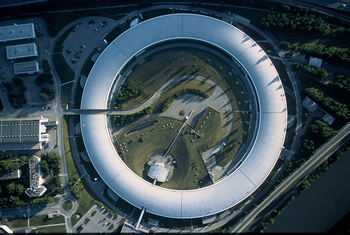
 The European Synchrotron Radiation Facility is a third generation synchrotron light source, jointly funded by 19 European countries. It operates 40 experimental stations in parallel, serving over 3500 scientific users per year. At the ESRF, physicists work side-by-side with chemists, materials scientists, biologists etc., and industrial applications are growing, notably in the fields of pharmaceuticals, petrochemicals and microelectronics. It is the largest and most diversified laboratory in Europe for X-ray science, and plays a central role in Europe for synchrotron radiation. The ESRF is currently engaging in a development programme for the next 10 years referred to as the Upgrade Programme. International collaborations will be paramount for the success of the ESRF Upgrade Programme, and cover many scientific disciplines including instrumentation and computing developments. ESRF provides the computing infrastructure to record and store raw data over a short period of time and also provides access to computing clusters and appropriate software to analyse the data. The ESRF will witness a dramatic increase in data production due to new detectors, novel experimental methods, and a more efficient use of the experimental stations. The Upgrade Programme will push a significant part of the ESRF beamlines to unprecedented performances and will further increase the data production from currently 1.5 TB/day by possibly three orders of magnitude in ten years from now. The ESRF has a long track record of successful international collaborations in many different fields of science and technology (SPINE, BIOXHIT, eDNA, X-TIP, SAXIER, TOTALCRYST, etc.). Three international projects are of direct relevance to PaNdata – the international TANGO control system collaboration, ISPyB, and SMIS. The TANGO control system was initially developed for the control of the accelerator complex and the beamlines at ESRF and has been adopted by SOLEIL, ELETTRA, ALBA, and DESY. It shows that five of the PaNdata partners are already working together in software developments of common interest. ISPyB is part of the European funded project BIOXHIT for managing protein crystallography experiments. In its current state, it manages the experiment metadata and data curation for protein crystallography. The SMIS project is the ESRF's database for handling users and experiments.
The European Synchrotron Radiation Facility is a third generation synchrotron light source, jointly funded by 19 European countries. It operates 40 experimental stations in parallel, serving over 3500 scientific users per year. At the ESRF, physicists work side-by-side with chemists, materials scientists, biologists etc., and industrial applications are growing, notably in the fields of pharmaceuticals, petrochemicals and microelectronics. It is the largest and most diversified laboratory in Europe for X-ray science, and plays a central role in Europe for synchrotron radiation. The ESRF is currently engaging in a development programme for the next 10 years referred to as the Upgrade Programme. International collaborations will be paramount for the success of the ESRF Upgrade Programme, and cover many scientific disciplines including instrumentation and computing developments. ESRF provides the computing infrastructure to record and store raw data over a short period of time and also provides access to computing clusters and appropriate software to analyse the data. The ESRF will witness a dramatic increase in data production due to new detectors, novel experimental methods, and a more efficient use of the experimental stations. The Upgrade Programme will push a significant part of the ESRF beamlines to unprecedented performances and will further increase the data production from currently 1.5 TB/day by possibly three orders of magnitude in ten years from now. The ESRF has a long track record of successful international collaborations in many different fields of science and technology (SPINE, BIOXHIT, eDNA, X-TIP, SAXIER, TOTALCRYST, etc.). Three international projects are of direct relevance to PaNdata – the international TANGO control system collaboration, ISPyB, and SMIS. The TANGO control system was initially developed for the control of the accelerator complex and the beamlines at ESRF and has been adopted by SOLEIL, ELETTRA, ALBA, and DESY. It shows that five of the PaNdata partners are already working together in software developments of common interest. ISPyB is part of the European funded project BIOXHIT for managing protein crystallography experiments. In its current state, it manages the experiment metadata and data curation for protein crystallography. The SMIS project is the ESRF's database for handling users and experiments.
